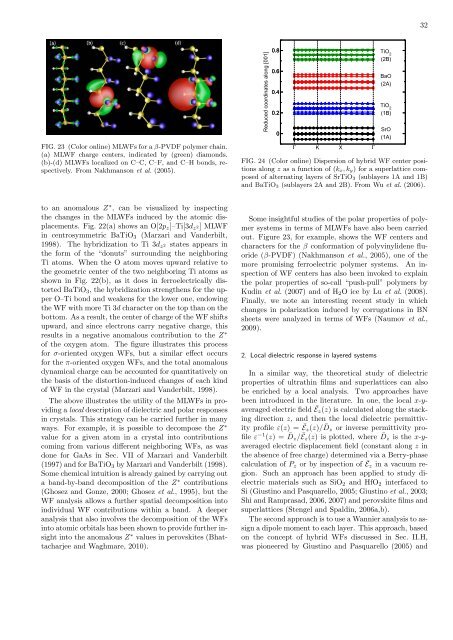Maximally localized Wannier functions: Theory and applications
Maximally localized Wannier functions: Theory and applications
Maximally localized Wannier functions: Theory and applications
Create successful ePaper yourself
Turn your PDF publications into a flip-book with our unique Google optimized e-Paper software.
32<br />
FIG. 23 (Color online) MLWFs for a β-PVDF polymer chain.<br />
(a) MLWF charge centers, indicated by (green) diamonds.<br />
(b)-(d) MLWFs <strong>localized</strong> on C–C, C–F, <strong>and</strong> C–H bonds, respectively.<br />
From Nakhmanson et al. (2005).<br />
Reduced coordinates along [001]<br />
0.8 TiO 2<br />
(2B)<br />
0.6<br />
0.4<br />
0.2<br />
0<br />
Γ K X Γ<br />
BaO<br />
(2A)<br />
TiO 2<br />
(1B)<br />
SrO<br />
(1A)<br />
FIG. 24 (Color online) Dispersion of hybrid WF center positions<br />
along z as a function of (k x , k y ) for a superlattice composed<br />
of alternating layers of SrTiO 3 (sublayers 1A <strong>and</strong> 1B)<br />
<strong>and</strong> BaTiO 3 (sublayers 2A <strong>and</strong> 2B). From Wu et al. (2006).<br />
to an anomalous Z ∗ , can be visualized by inspecting<br />
the changes in the MLWFs induced by the atomic displacements.<br />
Fig. 22(a) shows an O[2p z ]–Ti[3d z 2] MLWF<br />
in centrosymmetric BaTiO 3 (Marzari <strong>and</strong> V<strong>and</strong>erbilt,<br />
1998). The hybridization to Ti 3d z 2 states appears in<br />
the form of the “donuts” surrounding the neighboring<br />
Ti atoms. When the O atom moves upward relative to<br />
the geometric center of the two neighboring Ti atoms as<br />
shown in Fig. 22(b), as it does in ferroelectrically distorted<br />
BaTiO 3 , the hybridization strengthens for the upper<br />
O–Ti bond <strong>and</strong> weakens for the lower one, endowing<br />
the WF with more Ti 3d character on the top than on the<br />
bottom. As a result, the center of charge of the WF shifts<br />
upward, <strong>and</strong> since electrons carry negative charge, this<br />
results in a negative anomalous contribution to the Z ∗<br />
of the oxygen atom. The figure illustrates this process<br />
for σ-oriented oxygen WFs, but a similar effect occurs<br />
for the π-oriented oxygen WFs, <strong>and</strong> the total anomalous<br />
dynamical charge can be accounted for quantitatively on<br />
the basis of the distortion-induced changes of each kind<br />
of WF in the crystal (Marzari <strong>and</strong> V<strong>and</strong>erbilt, 1998).<br />
The above illustrates the utility of the MLWFs in providing<br />
a local description of dielectric <strong>and</strong> polar responses<br />
in crystals. This strategy can be carried further in many<br />
ways. For example, it is possible to decompose the Z ∗<br />
value for a given atom in a crystal into contributions<br />
coming from various different neighboring WFs, as was<br />
done for GaAs in Sec. VII of Marzari <strong>and</strong> V<strong>and</strong>erbilt<br />
(1997) <strong>and</strong> for BaTiO 3 by Marzari <strong>and</strong> V<strong>and</strong>erbilt (1998).<br />
Some chemical intuition is already gained by carrying out<br />
a b<strong>and</strong>-by-b<strong>and</strong> decomposition of the Z ∗ contributions<br />
(Ghosez <strong>and</strong> Gonze, 2000; Ghosez et al., 1995), but the<br />
WF analysis allows a further spatial decomposition into<br />
individual WF contributions within a b<strong>and</strong>. A deeper<br />
analysis that also involves the decomposition of the WFs<br />
into atomic orbitals has been shown to provide further insight<br />
into the anomalous Z ∗ values in perovskites (Bhattacharjee<br />
<strong>and</strong> Waghmare, 2010).<br />
Some insightful studies of the polar properties of polymer<br />
systems in terms of MLWFs have also been carried<br />
out. Figure 23, for example, shows the WF centers <strong>and</strong><br />
characters for the β conformation of polyvinylidene fluoride<br />
(β-PVDF) (Nakhmanson et al., 2005), one of the<br />
more promising ferroelectric polymer systems. An inspection<br />
of WF centers has also been invoked to explain<br />
the polar properties of so-call “push-pull” polymers by<br />
Kudin et al. (2007) <strong>and</strong> of H 2 O ice by Lu et al. (2008).<br />
Finally, we note an interesting recent study in which<br />
changes in polarization induced by corrugations in BN<br />
sheets were analyzed in terms of WFs (Naumov et al.,<br />
2009).<br />
2. Local dielectric response in layered systems<br />
In a similar way, the theoretical study of dielectric<br />
properties of ultrathin films <strong>and</strong> superlattices can also<br />
be enriched by a local analysis. Two approaches have<br />
been introduced in the literature. In one, the local x-yaveraged<br />
electric field Ēz(z) is calculated along the stacking<br />
direction z, <strong>and</strong> then the local dielectric permittivity<br />
profile ε(z) = Ēz(z)/ ¯D z or inverse permittivity profile<br />
ε −1 (z) = ¯D z /Ēz(z) is plotted, where ¯D z is the x-yaveraged<br />
electric displacement field (constant along z in<br />
the absence of free charge) determined via a Berry-phase<br />
calculation of P z or by inspection of Ēz in a vacuum region.<br />
Such an approach has been applied to study dielectric<br />
materials such as SiO 2 <strong>and</strong> HfO 2 interfaced to<br />
Si (Giustino <strong>and</strong> Pasquarello, 2005; Giustino et al., 2003;<br />
Shi <strong>and</strong> Ramprasad, 2006, 2007) <strong>and</strong> perovskite films <strong>and</strong><br />
superlattices (Stengel <strong>and</strong> Spaldin, 2006a,b).<br />
The second approach is to use a <strong>Wannier</strong> analysis to assign<br />
a dipole moment to each layer. This approach, based<br />
on the concept of hybrid WFs discussed in Sec. II.H,<br />
was pioneered by Giustino <strong>and</strong> Pasquarello (2005) <strong>and</strong>













